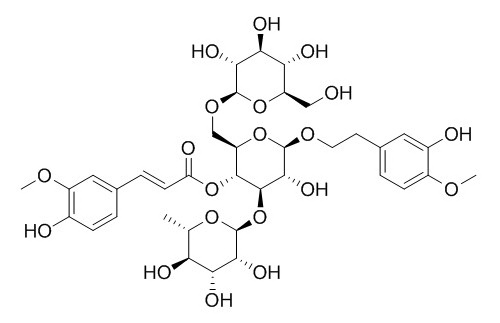Jionoside B1
Jionoside B1 has immunosuppressive activity, it shows the hepato-protective activity in the H2O2 induced liver injury experiments.Jionoside B1 exhibits the obvious inhibition against aldose reductase.
Inquire / Order:
manager@chemfaces.com
Technical Inquiries:
service@chemfaces.com
Tel:
+86-27-84237783
Fax:
+86-27-84254680
Address:
1 Building, No. 83, CheCheng Rd., Wuhan Economic and Technological Development Zone, Wuhan, Hubei 430056, PRC
Providing storage is as stated on the product vial and the vial is kept tightly sealed, the product can be stored for up to
24 months(2-8C).
Wherever possible, you should prepare and use solutions on the same day. However, if you need to make up stock solutions in advance, we recommend that you store the solution as aliquots in tightly sealed vials at -20C. Generally, these will be useable for up to two weeks. Before use, and prior to opening the vial we recommend that you allow your product to equilibrate to room temperature for at least 1 hour.
Need more advice on solubility, usage and handling? Please email to: service@chemfaces.com
The packaging of the product may have turned upside down during transportation, resulting in the natural compounds adhering to the neck or cap of the vial. take the vial out of its packaging and gently shake to let the compounds fall to the bottom of the vial. for liquid products, centrifuge at 200-500 RPM to gather the liquid at the bottom of the vial. try to avoid loss or contamination during handling.
J of the Korean Society of Cosmetics and Cosmetology2018, 399-406
J Clin Transl Hepatol.2023, 11(4):863-876.
J. of Agricultural Science2015, 1916-9760
Appl. Sci. 2021, 11(23),11099.
Molecules.2018, 23(7):E1659
Microchemical Journal2014, 203:110804.
Antioxidants (Basel).2021, 10(11): 1802.
Chem Biol Interact.2024, 395:110999.
J Basic Clin Physiol Pharmacol.2016, 27(1):1-8
LWT2021, 138:110630.
Related and Featured Products
Chinese Traditional & Herbal Drugs, 2016, 47(11): 1830-3.
Chemical constituents from whole plants of oehmannia chingii[Reference:
WebLink]
To investigate the chemical constituents of Rehmannia chingii.
METHODS AND RESULTS:
The compounds were isolated from an aqueous extract from the whole plants of R.chingii by a combination of various chromatographic techniques including column chromatography over silica gel and Sephadex LH-20 and reversed-phase HPLC.Their structures were identified by spectroscopic analysis including MS and NMR data.
Seventeen compounds were isolated and identified as 8-methyloctahydrocyclopenta [c] pyran-1,3,6,8-tetraol(1),3,4-dihydroxy-phenethyl alcohol(2),3-methoxyl-4-hydroxyphenyl alcohol(3),phenylethyl-8-O-β-D-glucopyranoside(4),3,4-dihydroxy-β-phenethyl-O-α-L-rhamnopyranosyl-(1→3)-O-β-D-glucopyranoside(5),2-phenylethylO-β-D-xylopyranosyl-(1→6)-β-D-glucopyranoside(6),deacyl-martynoside(7),acteoside(8),isoacteoside(9),martynoside(10),isomartynoside(11),jionoside C(12),jionoside A1(13),Jionoside B1(14),3,4-dihydroxy-β-phenethyl-O-α-L-rhamnopyranosyl-(1→3)-O-β-D-galacopyranosyl-(1→6)-4-O-caffeoyl-β-D-glucopyranoside(15),cistanoside F(16),and isocistanoside F(17).
CONCLUSIONS:
Among the isolated seventeen compounds,compound 1 is a new compound named rehmachinin,and compounds 16-17 are isolated from the plants of Rehmannia Libosch.ex Fisch.et Mey.for the first time.
In the preliminary assays,compounds 9,12,and 14-16 exhibit the obvious inhibition against aldose reductase.
Zhongguo Zhong Yao Za Zhi. 2011 Nov;36(22):3125-9.
Chemical constituents from Rehmannia glutinosa.[Pubmed:
22375391]
To study the chemical constituents from the roots of Rehmannia glutinosa.
METHODS AND RESULTS:
The compounds were isolated by various chromatographic methods and identified by spectroscopic analysis.
Twelve compounds were isolated and their structures were identified as 5-hydroxymethyl-pyrrole-2-carbaldehyde (1), 5-hydroxymethyl furfural (2), tyrosol (3), 5,6-dihydroxy-beta-ionone (4), 6-O-E-feruloyl ajugol (5), acteoside (6), leucosceptoside A (7), martynoside (8), isomartynoside (9), purpureaside C (10), jionoside A1 (11), and Jionoside B1 (12).
CONCLUSIONS:
Compounds 1, 3 and 9 were isolated from the genus Rehmannia for the first time.



